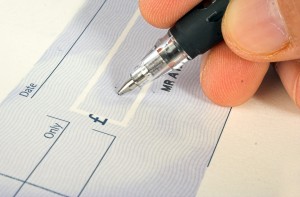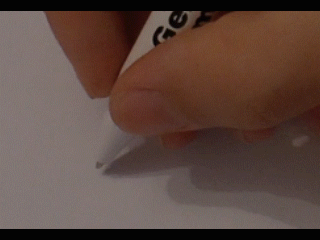This is not a blog post about pentesting, or any other kind of software-engineering inspired testing of pens. Nor is it a blog post about the kind of fascination some people have with pens and ink. Instead, this is a blog post about history and psychology.
Recently, JTA asked me what I do when I want to test a pen, and he was surprised with the answer. Before I tell you how I answered, I’ll tell you about what I learned from the conversation. And before that, I’ll tell you about the history of pen testing. And then, finally, I’ll tell you why I think it’s important from a psychological perspective.

Historically, the “breaking in” of a new pen was called a probatio pennae, literally “pen test”, and would typically be a few lines of text or a short proverb: something that demonstrated the pen’s ability to write. For the entire mediaeval period, plus several centuries besides, the principle instrument for writing would be the quill pen: the primary wing feathers of a large bird such as a goose, often hardened in hot ashes, stripped of barbs, and cut down to size with an blade whose purpose lends its name to what we now call a “pen knife”. With such a tool, a scribe would want to be sure that the pen could hold an adequate nibful of ink without splashing or spraying, and – despite the high value of paper – it was clearly essential to write a whole sentence or two to be sure.

A modern ballpoint pen has no such issues, but instead introduces some of its own: a plastic-lined inkwell can be gradually penetrated by the air, causing the ink to dry up; the ball can become stuck and will not turn freely; air bubble can develop within the tube (especially if the pen is stored, or worse-still used, the wrong way up); and, of course, the pen can run out of ink. This typically precipitates its disposal: your biro isn’t built to be re-used for anything except perhaps to perform an emergency tracheotomy, and it’s cheap enough that you don’t want to waste your time repairing it. As a result, our pen tests have become fast, designed to determine within a few seconds whether the pen we’ve got is working or, in the case of a stuck ball, can be made to start working with a sufficiency of scribbling. Our culture of disposal can’t spare the time for any more than a cursory test before we give up and grab the next one.

So what do we write? What is the probatio pennae of our times? It’s been widely-reported (although I can’t find any decent citations) that, upon being offered a new pen to try out, 97% of people will write their own name. Now that statistic smells fishy to me (no good citations anywhere, and 97% of people use 97% as their “virtually all” number, for made-up statistics), but I’ve been testing the hypothesis among friends these last few days, and I’ve gathered enough evidence to convince me that it’s probably the case that many or most people will write their own name to test a pen.

Somebody had presumably asked JTA what he wrote, earlier in the day, because he took the time to tell me that when he tests a new pen, he typically writes the word “hello”.
Now I find that pretty weird. Maybe it’s the software engineer in me, but to me the mark of a good test is that it covers all of the possible cases, in the minimal possible effort. Writing your name is easy because it’s managed by what is popularly-called “muscle memory”: a second-season episode of Castle (correctly) used this as a plot point, when a man suffering from retrograde amnesia was unable to remember his name, but was still able to sign his name because the act of signing it had been rendered, by years of practice, into his procedural memory, which was unaffected by his condition. But writing a word, like “hello”… requires a comprehension of language. Unless he’s tested enough pens to have built a procedural memory of writing “hello” to test pens, JTA’s test has a greater number of neural dependencies, which – with apologies to those of you who aren’t interested in automated software testing – produces what we’d call an unnecessarily “brittle” test.

Me? I just scribble, which my quick survey (and several comparable ones online) show to be probably the second-most popular action to test a pen. Scribbling, to me, simply seems like the minimal test path: the single simplest thing that can be done with a pen that will demonstrate that it’s fit for purpose. I don’t need to test that a new pen can write words, because – to me – writing words in particular is not a function of the pen, but a function of my brain! To me, the pen’s function is simply one of transferring ink to the paper, and any semantic meaning coming from the ink is a product of my intellect, not of the writing implement.
So why is this important? Well: I have a half-baked hypothesis that the choice of what to write with a new pen might be linked to other aspects of our psychology. When I’m developing a new template for a website, for example, I use lorem ipsum text and dummy placeholder images as filler (just occasionally, I’ll use kittens, because kittens are adorable). That’s because the absence of meaning to the words that appear (I don’t read Latin, and even if I did, lorem ipsum is frequently mangled) has no bearing on my comprehension of the design: and, in fact, it can sometimes be a benefit to be deprived of the distraction of legible content.

But I’d hypothesise that people who write words as a probatio pennae would be less-comfortable with illegible placeholder-text in a design than those who drew scribbles or signed their name. I have a notion, from my own experience, that the same parts of the brain that is responsible for judging the quality of a writing implement are used in the judgement of a piece of design work. Hey: maybe if that’s true, graphic designers should have their clients test pens out, in their presence, before they decide whether to use believable filler or lorem ipsum text in the designs they’d like approved.
Or maybe I’m way off base. What do you write when you test a pen?